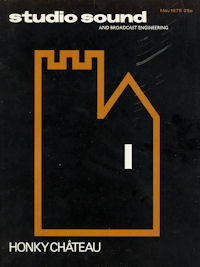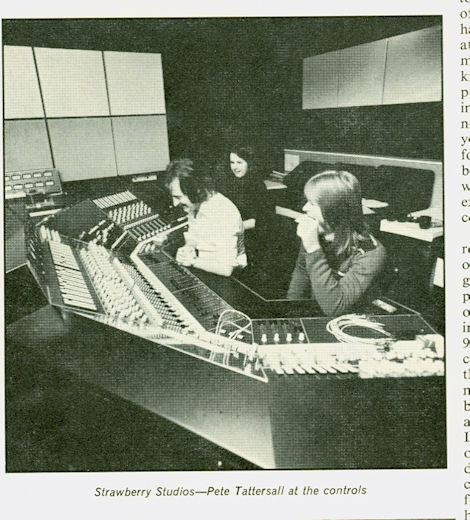
A celebration of Strawberry Recording Studios, Stockport,
1967 - 1993.

1975, May, p46
STRAWBERRY
By Frank Ogden
VERY CONGENIAL. That sums up a recent visit to Strawberry Studios up in Manchester. The studio has been covered in much detail by John Dwyer (see July 74) which means that apart from the installation of a single seater ladies lavatory and a Dolby E2 cinema equaliser, there is no change in the hardware situation. This makes repetition of facilities unnecessary.
Pete Tattersall, director, studio manager and mixing engineer, stumbled into the reception area looking like a washed out version of Sancho Villa; the man had been on an all night session with 10cc for The Original Soundtrack. After a few cups of coffee, he was in suitable condition to offer a guided tour of the studio pointing out new features mentioned above. The benefits of the lavatory are obvious; the Dolby equaliser deserves rather more explanation. Originally developed for use with 364 cinema noise reduction module, the E2 unit offers a basic 27 third-octave bands for full spectrum eq. In the Strawberry installation, the equaliser processes the signal to the monitor amps resulting in a control room with artificially flat acoustics. On the E2, the bands are adjusted by presets contained on cards mounted within; they seldom need adjustment. After setting up on pink noise with the measurement mic above the desk, the 'flat' area extends for the length of the console, more than sufficient for an energetic mixdown man. The studio floor was strewn with instruments, boxes, mics, cans and other wreckage of protracted endeavours from the previous night. Returning once more to the control room, pungent oriental spices greeted the nostrils. The 10cc men had shown up for work laden with take-away Chinese nosh.
The meeting was adjourned to a fine hostelry offering a choice of Robinson's most excellent ales. Over and after a few, Pete told of the future plans for the studio. Irs going 24 track. He wasn't quite certain when but it should be in the near future. Strawberry people don't like to rush into things, they won't let themselves be tied down by merchant bank cash. Hence, they earn money before they spend it. This philosophy built the studio from a mono tape recorder and it's still good when expanding from 16 led and running by the beginning to 24 track.
Asked about the need for a larger system, Pete parried with an example of engineering on a recent album by 10cc. On one track, there were no fewer than 253 over dubs to get the final mix. A 24 track machine would represent quite a time saving on a job like that. Problems of noise didn't appear to worry him very much; he displayed considerable faith in Dolby and modern tape to cover up all but the nastiest buildups. About automated mixing he wasn't quite so sure. 'It's the cream on top of the cake. Nice, but not essential.'
